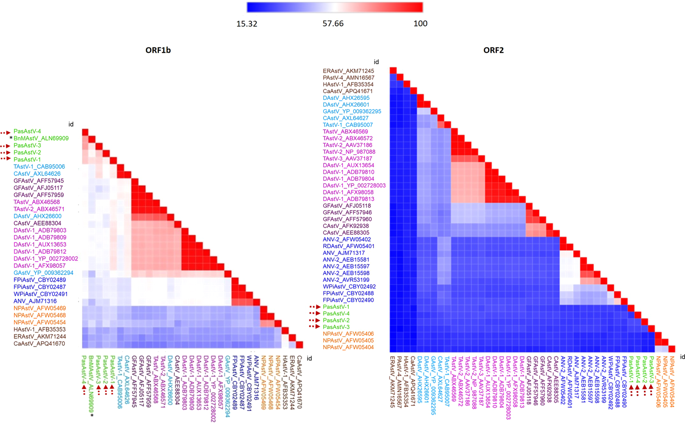Scientific Reports ( IF 3.8 ) Pub Date : 2019-07-02 , DOI: 10.1038/s41598-019-45889-3
Izaskun Fernández-Correa 1 , Daniel A Truchado 1, 2 , Esperanza Gomez-Lucia 3 , Ana Doménech 3 , Javier Pérez-Tris 2 , Jonas Schmidt-Chanasit 4, 5 , Daniel Cadar 4 , Laura Benítez 1

|
Metagenomics is helping to expand the known diversity of viruses, especially of those with poorly studied hosts in remote areas. The Neotropical region harbors a considerable diversity of avian species that may play a role as both host and short-distance vectors of unknown viruses. Viral metagenomics of cloacal swabs from 50 Neotropical birds collected in French Guiana revealed the presence of four complete astrovirus genomes. They constitute an early diverging novel monophyletic clade within the Avastrovirus phylogeny, representing a putative new astrovirus species (provisionally designated as Avastrovirus 5) according to the International Committee on Taxonomy of Viruses (ICTV) classification criteria. Their genomic organization shares some characteristics with Avastrovirus but also with Mamastrovirus. The pan-astrovirus RT-PCR analysis of the cloacal samples of 406 wild Neotropical birds showed a community-level prevalence of 4.9% (5.1% in passerines, the highest described so far in this order of birds). By screening birds of a remote region, we expanded the known host range of astroviruses to the avian families Cardinalidae, Conopophagidae, Furnariidae, Thamnophilidae, Turdidae and Tyrannidae. Our results provide important first insights into the unexplored viral communities, the ecology, epidemiology and features of host-pathogen interactions that shape the evolution of avastroviruses in a remote Neotropical rainforest.
中文翻译:

来自新热带雀形目鸟类的一组新颖的禽星状病毒扩大了星状病毒科的多样性和寄主范围。
元基因组学正在帮助扩大已知的病毒多样性,尤其是那些偏远地区宿主研究不完善的病毒。新热带地区拥有大量鸟类,它们既可以作为未知病毒的宿主载体,也可以作为短距离病毒的载体。在法属圭亚那收集的来自50只新热带鸟类的泄殖腔拭子的病毒宏基因组学揭示了存在四个完整的星状病毒基因组。它们构成了内的早期发散新颖单系Avastrovirus系统发育,代表推定的新的星状病毒物种(暂时地指定为Avastrovirus 5根据国际病毒分类委员会(ICTV)分类标准)。他们的基因组组织与星状病毒也可与乳腺病毒一起使用。对406只野生新热带鸟类的泄殖腔样本进行的全天文病毒RT-PCR分析显示,社区水平的患病率为4.9%(雀形目为5.1%,是迄今为止该鸟类中描述的最高水平)。通过筛选偏远地区的鸟类,我们将星状病毒的已知宿主范围扩展到了红雀科,孔雀科,呋喃科,嗜热杆菌科,Turdidae和暴龙科的鸟类家族。我们的结果为未开发的病毒群落,生态学,流行病学和宿主-病原体相互作用的特征提供了重要的初步见解,这些特征决定了偏远的新热带雨林中星状病毒的进化。































 京公网安备 11010802027423号
京公网安备 11010802027423号